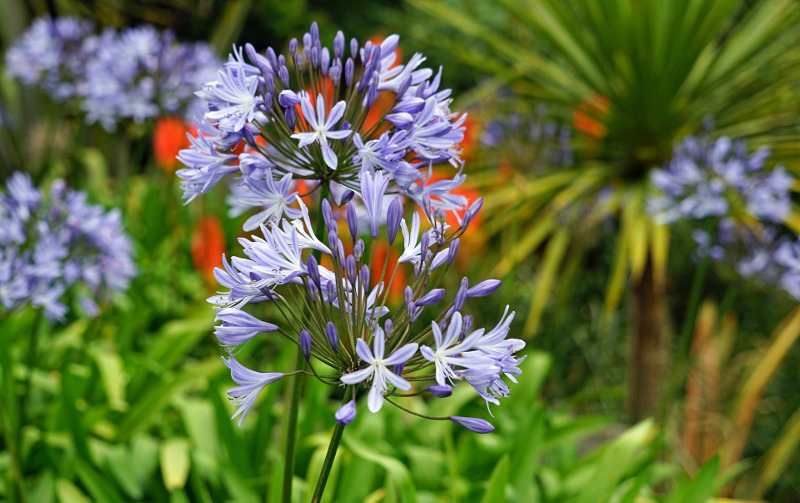Mastering the Art of Agapanthus Care: Important Steps for Healthy And Balanced Development and Vivid Flowers
In the world of cultivation, the growing of agapanthus stands as a gratifying endeavor for those that look for to nurture these classy blooming plants. With their striking blooms and elegant vegetation, agapanthus has recorded the interest of garden enthusiasts worldwide. Nevertheless, achieving optimum growth and vivid blossoms calls for a nuanced method that incorporates different essential actions. From picking the ideal variety to grasping trimming techniques, the journey towards growing flourishing agapanthus plants is complex and holds the essential to opening the complete potential of these organic treasures.

Choosing the Right Agapanthus Selection

When selecting the ideal Agapanthus range for your garden, think about factors such as climate suitability, flower color, and development habit. In addition, think about the environment in your area to make certain the Agapanthus selection you select can thrive in your certain problems. Recognizing the development routine of various Agapanthus varieties is important for appropriate placement within your yard.
Suitable Growing Conditions
Considering the ideal environmental requirements is important for effective Agapanthus farming. Agapanthus flourishes in well-draining dirt with a somewhat acidic to neutral pH degree. When growing, choose a location that receives full sunlight to partial shade. In hotter climates, providing some mid-day color can prevent scorching of the fallen leaves. Agapanthus plants are delicate to cool temperature levels and need to be shielded from frost during cold weather.
To guarantee healthy development and vivid blossoms, plant Agapanthus bulbs at a depth of regarding 2-4 inches and area them 8-12 inches apart. Including raw material, such as compost, to the soil can improve drain and fertility, promoting robust root advancement. Mulching around the base of the plants assists maintain moisture and reduces weed growth. Routine watering is vital, specifically throughout the expanding period, to maintain the dirt constantly wet but not waterlogged.
Watering and Fertilizing Tips
Maintaining correct dampness levels and providing essential nutrients are crucial elements in the treatment program for Agapanthus plants. When it comes to sprinkling Agapanthus, it is vital to strike a balance. These plants favor regularly moist soil yet are prone to root rot if overwatered.
Fertilizing Agapanthus is vital for advertising healthy growth and prolific blossoms. Use a balanced fertilizer, such as a 10-10-10 formula, in the very early springtime as brand-new growth emerges. By complying with these watering and feeding tips, you can ensure your Agapanthus plants prosper and generate lively, durable blooms.
Pruning Methods for Agapanthus
Trimming Agapanthus plants at the proper times and with correct methods is essential for maintaining their health and promoting ideal development and blooming. The ideal time to prune Agapanthus is in late wintertime or very early springtime prior to brand-new growth emerges. Start by removing any dead or yellowing fallen leaves near the base of the plant. Cut them as short as feasible without harming the arising shoots.
For flowered stems, wait up until the blooms have withered and then cut them back to the base. This not just cleans the plant's look however likewise encourages the development of new blossom buds. Deadheading invested blossoms can likewise redirect the plant's energy right into generating even more flowers instead of setting seeds. Nonetheless, if you desire to accumulate seeds for proliferation, leave some flowers to completely dry and fully grown on the plant.
Remember to use tidy, sharp devices to make precise cuts and reduce the discover this danger of presenting conditions. Agapanthus. Regular trimming will certainly help keep your Agapanthus looking healthy and cool while ensuring a plentiful screen of lovely blooms
Handling Common Bugs and Conditions
After making sure proper pruning techniques for Agapanthus, it is vital to attend to common parasites and diseases that can impact the health and vigor of these plants. Agapanthus plants are typically durable yet can still succumb to specific issues. One common bug that impacts Agapanthus is the Agapanthus gall midge. This small, orange fly lays visit site its eggs in the foliage, causing altered growth and flower buds that stop working to open. To fight this bug, prune and destroy any affected plant parts and take into consideration using insecticidal soap.
In addition, Agapanthus plants can endure from origin rot if they are grown in poorly draining soil. By being cautious and taking prompt action versus conditions and bugs, you can aid your Agapanthus plants thrive and generate lively flowers. Agapanthus.

Final Thought
In final thought, mastering the art of agapanthus treatment involves selecting the best range, supplying suitable growing conditions, correct watering and fertilizing, proper pruning techniques, and addressing usual pests and diseases. By complying with these necessary steps, you can make certain healthy development and dynamic flowers for your agapanthus plants. Bear in mind to frequently monitor and keep your plants to promote their general health and long blog life.
To make sure healthy and balanced growth and lively blooms, plant Agapanthus bulbs at a depth of regarding 2-4 inches and room them 8-12 inches apart. By following these watering and feeding tips, you can ensure your Agapanthus plants flourish and create dynamic, lasting blooms.
One typical bug that affects Agapanthus is the Agapanthus gall midget. In addition, Agapanthus plants can endure from root rot if they are grown in badly draining dirt. By following these crucial actions, you can ensure healthy development and vivid blossoms for your agapanthus plants.
Comments on “Agapanthus Companion Plants: Perfect Pairings for Your Yard”